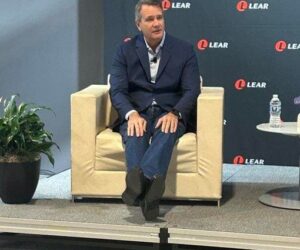Close-up of a person’s hand holding a smartphone and using the Opus 4 model within the Claude app from AI company Anthropic, Lafayette, California, May 22, 2025. (Photo by Smith Collection/Gado/Getty Images)
Gado via Getty Images
As one big tech CEO told me recently, “You don’t want to be parked on SaaS Ave. SaaS now is like building real estate in a bad neighborhood.”
He wasn’t being glib. The software landscape is shifting underfoot. We’ve entered the age of Agentic Platform Companies (APCs), a convergence of SaaS, software, and cloud built around adaptive, AI-powered systems. A system that intelligently connects a vast landscape of business applications to deliver insights and intelligence that traverses the enterprise environment and makes enterprise software as usable as ChatGPT or Google Search. In this new era, traditional SaaS economics are faltering, and mid-market players are in the crosshairs.
As I wrote in these pages nearly a year ago, SaaS companies that are looking to merely embed AI features into their existing software and seek to charge incremental fees are extremely vulnerable.
Water-cooler talk in Silicon Valley and beyond was bleaker, speculating on the end of SaaS, and the prospects of Salesforce, ServiceNow, Workday Inc., NetSuite Inc., and others.
A new AlixPartners study examined 122 publicly traded enterprise software companies with annual revenue of less than $10 billion, and found they are feeling what the firm calls the “big squeeze”: AI-native startups on one side, tech giants on the other.
Startups are releasing lower-cost, faster-evolving tools. Meanwhile, incumbents like Microsoft Corp., Salesforce Inc., and Oracle Corp. are doubling down on AI, embedding it into vast, bundled ecosystems and offering it at scale. The mid-tier, stripped of its traditional competitive advantages, is being forced into an uncomfortable choice: pivot or perish.
The numbers tell the story. The share of high-growth companies in this segment fell from 57% in 2023 to 39% this year. Net dollar retention, a key measure of customer stickiness, has dropped from 120% in 2021 to 108% in late 2024.
Markets have taken notice. The BVP Nasdaq Cloud Software Index is down nearly 10% year-to-date, even as the broader Nasdaq Composite is up more than 20%.
“SaaS Is Dead” — Sort Of
Microsoft CEO Satya Nadella reportedly implied “SaaS is dead” not as a eulogy, but as a warning–effectively labeling enterprise software as crud databases with logic on top. The dashboard-and-seat-license model is being eclipsed by AI agents: autonomous, adaptive systems that learn and execute without constant human input.
Several forces are driving this shift:
- AI-Driven Adaptability. Static workflows are giving way to dynamic, learning-based systems.
- Cloud-Native + Edge Computing. Processing is moving closer to the user for real-time decision-making.
- Composable Architecture. Modular, mix-and-match services are replacing monolithic applications.
- Token Economics. Outcomes driven by tokens, which will be powered by autonomous agents will deliver value. The entire consumption and pricing model will need to be rebuilt from the ground up.
Based on my interactions with insiders and CEOs, coupled with our market research, we believe it’s plausible that one-third to one-half of today’s SaaS companies will disappear—or be reduced to API-level data feeds for larger AI platforms—within 36 months.
We also believe there will be consolidation and a new stable of winners. Some of the companies are already building for this APC future. In no particular order, the best positioned include:
1. Alphabet (Google)
2. Microsoft
3. Palantir
4. ServiceNow
5. Amazon
6. Oracle
7. Salesforce
8. IBM
9. SAP
10. OpenAI
These firms aren’t adding AI as an accessory, they’re making it the operating core.
Oracle, for example, has turned around its cloud business while Microsoft and Google aim to overtake AWS within four years. AWS itself faces capital spending pressure to catch up on AI tools, even as it makes inroads in robotics.
Then there’s Palantir, a company many love to call overvalued, yet whose growth and margins continue to defy gravity. Its recent $10 billion U.S. Army contract cements it as a consolidation layer for AI, data, and software in some of the most secure markets in the world. CEO Alex Karp’s public persona, like Elon Musk’s, galvanizes retail investors. The only caution flag: Palantir’s valuation assumes flawless execution. And so far, it has delivered.
The SaaS Model is Under Siege
The traditional SaaS playbook of dashboards, seat-based pricing, and sprawling product catalogs is breaking down.
- AI Agents as Interfaces: Many tasks once handled through UIs are now delegated directly to AI.
- Outcome-Based Pricing: Firms like Salesforce and ServiceNow are experimenting with charging for results, not headcount.
- Data Consolidation: Fragmented SaaS stacks are being replaced by centralized data hubs to feed AI systems.
But this transformation comes with costs. Compute-intensive AI workloads increase operating expenses, squeezing margins. Investors are pushing for profitability overgrowth in a high-interest-rate environment.
For mid-market SaaS companies, survival requires more than bolting AI onto existing products. It demands reinvention: build products where AI is central, not peripheral; move toward usage- or outcome-based billing; cut underperforming offerings and redeploy capital into AI development; and acquire niche capabilities or position yourself as an acquisition target.
In some cases, the smartest move will be a controlled exit before valuations erode further.
This isn’t a routine technology upgrade cycle: It’s a structural shift in how software is built, sold, and valued. The winners will be agentic platforms delivering measurable outcomes. The losers will be those clinging to a model built for a pre-AI era.
The CEO who warned me about “SaaS Ave.” might have been blunt, but the analogy is apt. The neighborhood is changing fast. If you don’t adapt, you’re not just at risk of losing market share — you’re at risk of being erased.









